By Sophie Zhang, WEMT
About a month ago, I was asked if I wanted to join the instructor team for a Wilderness Life Support for Medical Professionals (WLS:MP) course in the Italian Dolomites. It was obviously a quick and easy ‘obviously, yes’. WLS:MP courses are geared towards medical professionals looking to earn CME and/or learn how to apply their medical knowledge to austere environments. I had been to WLS:MP classes before, however, this one was sure to be an entirely different experience. Most WLS:MP courses tend to be shorter (think two days) and are entirely focused on learning. MedTreks, however, was going to take the same curriculum and integrate it into a 9 day hiking trip through the Dolomites.
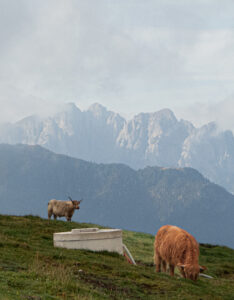
Due to some flight snafus, I had 36 hours of travel to reach Cortina d’Ampezzo. In the battle between anticipation and anxiety, I found myself firmly on the side of anxiety for the entirety of that time.
Ari Rasori, founder of MedTreks, is an experienced emergency room FNP, distinguished in global health initiatives, and an accomplished outdoorswoman. Chris VanTilburg has oodles of accolades in wilderness emergency medicine; he serves as the medical director for multiple SAR teams, has published books on outdoor recreation and safety, and is a Fellow in the Academy of Wilderness Medicine. Christian Dean, a doctor of osteopathic medicine, is an incredible outdoor athlete, a recurring medical provider at Everest base camp, and pursuing a fellowship in sports medicine. How was I, an EMT-B, going to stand next to such distinguished medical professionals and teach people with decades more experience and education than myself?
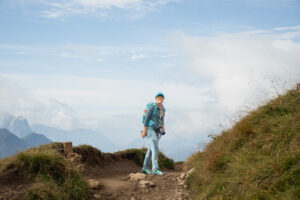
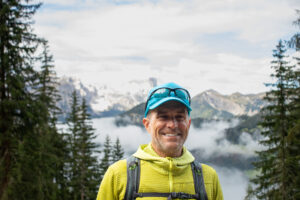
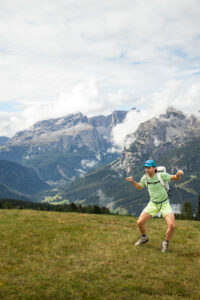
(LEFT) Ari Rasori, FNP and founder of MedTreks
(MIDDLE) Chris VanTilburg, MD
(RIGHT) Christian Dean, DO
As luck would have it, I was completely wrong in all my worries.
I (finally) arrived at our hotel while the class was out hiking. I waited for their return, sipping coffee, nervously bouncing my feet, and rehearsing how I was going to introduce myself. Ari arrived first, carrying a bag of medical supplies, smiling ear to ear, and effortlessly putting me at ease. She introduced me to our group, which consisted of an anesthesiologist, a PA, a DO, an ER nurse, a family medicine doctor, and a contractor. We were also joined by two Dolomites guides, Barbara and Susie. We dove into a lecture and skills section on cervical spine stabilization before heading off to our welcome dinner complete with South Tyrolean classics, wine, and gelato. I went to bed that evening exhausted but excited for the rest of the trip.
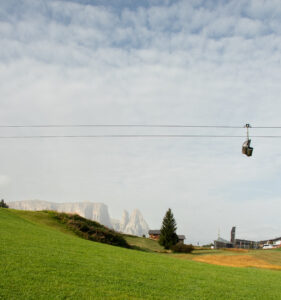
It’s hard to fully condense the experience into one blog post and I won’t try to do so. Instead, I want to share some of the memories that most stuck out to me.
Our group attempting to learn words from the Ladin language and, in return, walking our guides through how to pronounce such words as ‘rural’ and ‘brewery’.
Dr. Dean ‘passing out’ at one of the infamous mountain refugios as he simulates a patient who is struggling with heat illness. Then, 20 minutes later, Dr. Dean hurtling his body into a ditch as his ‘heat stroke’ progresses. The moment when our students’ voices changed from worry to laughter as they realize they’re in a scenario.
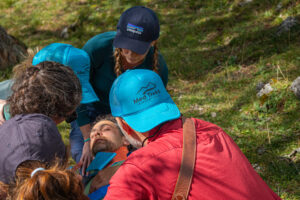

Dr. Dean’s heat stroke scenario
A daily ritual of ordering apple strudel and tiramisu for lunch and giving each a rating out of 10 (spoiler: Susie’s mother undisputedly makes the best tiramisu in the region).
A discussion on whether or not prophylactic hypothermia would be a reasonable intervention in the backcountry.
A student birthday mid-trip that was celebrated by a raucous round of ‘Happy Birthday’ every couple hours and a delicious 5 course meal in the evening.
The pinnacle of the trip, though, started one morning on a hike through the Val Gardena area when Ari turned to the group with a huge smile across her face. She informed us that there is a twice annual bike race (the Sellaronda Bike Race), happening that Saturday. The race, which covers 4 passes and 5500 feet of elevation gain over 32 miles, is a staple of the region; the roads are closed to motor vehicles as thousands of cyclists take to the roads. She asks us if we would like to amend our itinerary to include this race to which she received a resounding ‘yes’.

The day of the race comes and we all take to our bikes, all of us riding E-bikes with the exception of Dr. VanTilburg. The first three passes come and go. Our group is cruising up to the passes, admiring some breathtaking views, and then flying down the backside. The last pass, however, brings a new challenge. As we arrive at the top and celebrate the near end of the day, we hear yelling that someone has fallen down and needs medical attention. Dr. VanTilburg rushes over to find a gentleman pulseless and apneic. He begins CPR as bystanders start calling for medical support. An AED arrives, with directions given in Italian. An ambulance drives up with a couple of medics and more gear. Lastly, a helicopter lands on the hill, bringing a doctor toting a bag stuffed to the brim with supplies. He immediately gets IV access and intubates the gentleman. The patient is loaded into a litter, a LUCAS is strapped on to his chest, and he is loaded into the helicopter. All in all, the man was down for 18 minutes and, as we would later find out, was successfully extubated the following day.

(LEFT) The crew before starting the Sellaronda Bike Race
The helicopter lifts away and we turn back to our bikes. The last stretch is a series of switchbacks leading into town. I would be lying if I said that biking was a hobby of mine but this 20 minute stretch was by far and away my favorite experience of this whole trip. It’s almost an out of body experience for me, riding down this road. I am in the Dolomites, I am flying down this road and feeling the wind and sun on my cheeks, I am seeing cows wandering around and hearing the clang of their bells, I am teaching alongside a doctor who just saved a life in clip-in bike shoes. I am tired, I am proud, I am overwhelmed, and I am incredibly grateful. I feel unable to describe exactly how I found myself in this exact situation, and yet, I can not picture myself being anywhere else.
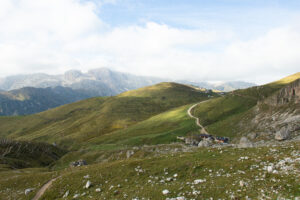
As someone with a career in wilderness medicine, I spend a lot of time thinking about, talking about, and living in the outdoor, healthcare, and education worlds. This course highlighted everything I love about those three things. The communities you forge doing outdoor sports, the never-ending learning opportunities in medicine, the opportunity to watch something ‘click’ in the minds of your students, the ability to save lives. I am incredibly grateful to MedTreks and Ari Rasori for including me on this trip, for her dedication to her students’ experience, and for providing classes that seamlessly integrate learning with adventure.
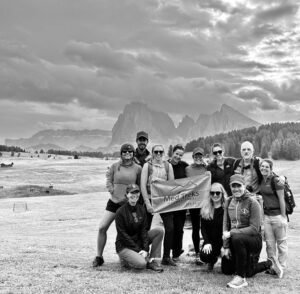
The whole group
This is why I got into the outdoors. This is why I got into medicine. This is why you should, too.

Me.
Medtreks International is excited to offer this trek in 2024! Visit here to learn more.